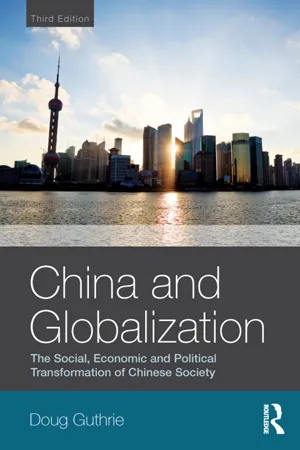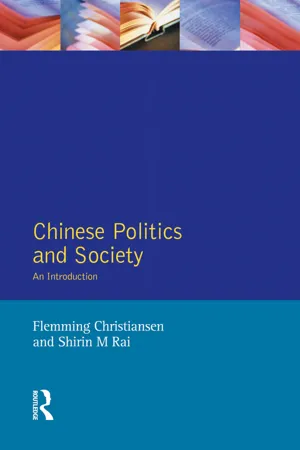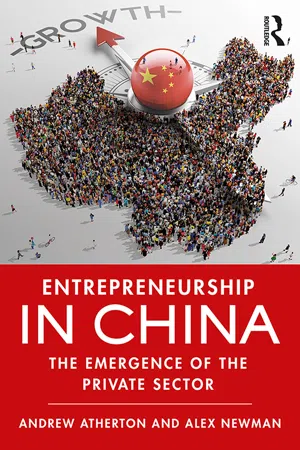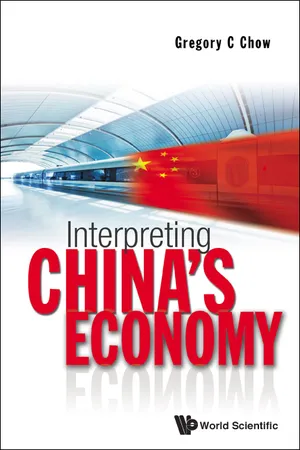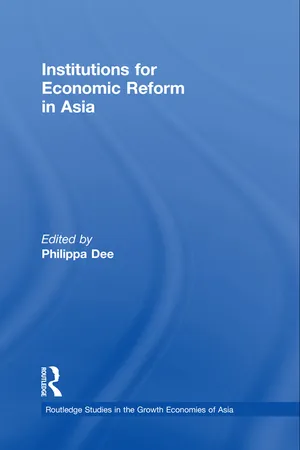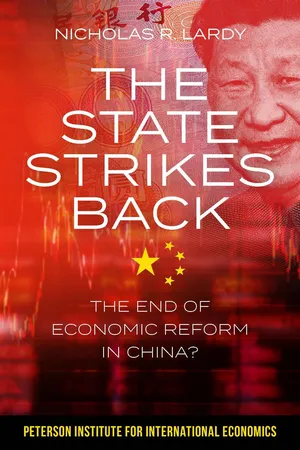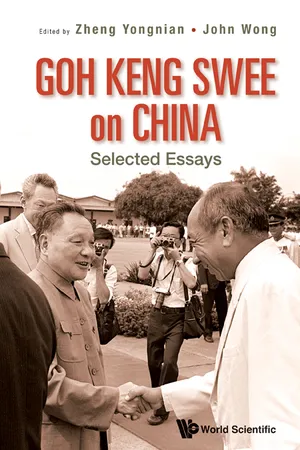Economics
Chinese Economy
The Chinese economy is one of the largest and fastest-growing in the world, characterized by its transition from a centrally planned to a market-based economy. It is driven by manufacturing, technology, and exports, and has experienced significant growth and development over the past few decades. The government plays a significant role in shaping economic policies and has implemented various reforms to sustain growth and stability.
Written by Perlego with AI-assistance
Related key terms
9 Key excerpts on "Chinese Economy"
- eBook - ePub
China and Globalization
The Social, Economic and Political Transformation of Chinese Society
- Doug Guthrie(Author)
- 2012(Publication Date)
- Routledge(Publisher)
China began with an export-led growth strategy but also oversaw the growth of an entrepreneurial collective and private sector from below; the transformation of the state sector from above; the attraction of foreign capital and the transfer of technology and the learning of management practices from their new foreign partners. It has been a complex process with many moving parts. However, while counterparts in Russia and Eastern Europe followed simplistic prescriptions about rapid privatization and the selling off of assets to foreign investors, China carefully balanced all of these moving parts to build a powerful and complex economy. In this chapter, I examine how it has come to be that China’s transition to a market economy has produced remarkable growth rates and fundamental changes in the organization of economic action. Though lacking the basic institutional shifts that have defined many transforming socialist economies around the world, China’s gradualist reforms have nevertheless been radical and deep. In order to understand the process of economic transformation in China, it is necessary to examine a few key areas of development. This list is by no means exhaustive, but it does comprise some of the key areas in which economic development has transformed China in fundamental ways. I look first at China’s engagement in global markets. Second, I examine the varieties and types of organizations that have been successful in transforming themselves in China’s market economy. Third, I look at the forces of change that have contributed to this success.The basic thesis of this chapter is that economic development in China has been shaped by three key factors. First, the central government has driven reforms forward through several key policies that have allowed China to engage fully in the global economy. These policies of engagement have had both external and internal orientations. In terms of China’s external focus, the most important policy has been the export-oriented coastal development strategy, which has played a key role in helping China to emerge as the second-largest trading economy in the world in 2010 (behind the United States), with total trade of $2.97 trillion (“total trade” is a sum of imports and exports). In terms of internal focus, the government has adopted a surprisingly open stance vis-à-vis foreign direct investment (FDI), liberalizing internal markets to a degree greater than is commonly understood and certainly to a greater extent than in India and Japan, for example, at similar stages of development. The reasons for aggressively attracting FDI range from capturing advanced technology through technology transfer agreements and studying management practices from advanced market economies to attracting foreign capital. Second, the government decentralized decision making in significant ways. This point cannot be overemphasized: the decentralization of economic decision-making is one of the key factors that has pushed China’s reform effort forward. This economic decentralization had several key effects, including giving incentives for local development to local officials and creating competition among localities. Third, while the government has reformed industrial organizations without privatization, it has, at the same time, allowed a private economy to emerge from below. This is an important distinction: in the sector controlled by the Chinese state, state-owned enterprises (SOEs) (guoying qiye or guoyou qiye ), urban collectives (jiti qiye ), and township and village enterprises (TVEs) (xiangzhen qiye ) remained state owned throughout much of the reform era (though collectives and TVEs have increasingly been sold off or bought out by local entrepreneurs and employees in the last decade). Though the incentives for such enterprises shifted downward and were placed in the hands of local officials, they remained state property in the early years of the reform. They have been transformed through a process of reform without - eBook - ePub
Chinese Politics and Society
An Introduction
- Flemming Christiansen, Shirin M. Rai(Authors)
- 2014(Publication Date)
- Routledge(Publisher)
PART III The economyThe Chinese Economy is in all respects an important political factor. The Chinese path of development has been based on the planned economy. The political structures for managing the economy have, throughout the period, been of prime importance in the Chinese state and have determined the availability of policy options. The two chapters in this part focus on the political—economic apparatus and its dynamics, which are very different from those in capitalist countries. Chapter 9 describes the economic system of the 1950s to the 1970s, outlining the justifications and inherent problems of the planned economy. Chapter 10 examines the Chinese economic system since 1976, indicating two strategies for growth: Hua Guofeng's unsuccessful attempt, and the reform policy initiated by Deng Xiaoping. The legacy of the planned economy and the continued state intervention in the economy proved to constitute a dynamic stimulus for economic growth.Passage contains an image
9 The Chinese Economy I (1949–1976)China's economy in the 1950s until the early 1980s was a fully fledged socialist economy, and thereafter it has increasingly turned into a mixed economy, which officially is called a ‘socialist market economy’. Here we explore China's unique path to economic development in two chapters. In this chapter we present the formation of the socialist economy in the early and mid-1950s, discuss the shock of the Great Leap Forward, the stabilization of growth in the early 1960s, the stagnation of the Cultural Revolution and the suppressed development of the early 1970s.THE FOUNDATIONS OF THE SOCIALIST ECONOMY
The socialist economy, as it was introduced in China in the early 1950s and continued to exist for over 30 years, differs radically from liberal market economies. The state controlled the economy by enforcing a state plan. It also monopolized the distribution of all goods and commodities. Instead of attempting a formalistic definition of a socialist economy here, we want to outline the moral justifications and ideological origins of the economic formation in China, and describe how it was brought into reality by the Chinese Communist Party. - eBook - ePub
Entrepreneurship in China
The Emergence of the Private Sector
- Andrew Atherton, Alex Newman(Authors)
- 2017(Publication Date)
- Routledge(Publisher)
China’s markets are highly competitive, with most major global businesses active, alongside entrepreneurial private Chinese businesses, government-supported state-owned enterprises (SOEs), and smaller enterprising businesses from the West and other Asian countries. Some of these businesses are aggressive price discounters who can absorb low margins or losses for sustained periods. Although demand is high, competition is intense and increasing.The rise in the number of private ventures operating in China, alongside the market influence of SOEs, means that indigenous competition is strong. Foreign entrants intensify this competition as they seek market share and niches. As discussed later in this chapter, local private enterprises are becoming more sophisticated, better managed and able to deploy a combination of technical skills and local knowledge to develop business models and products that are highly competitive in China. Success in Chinese markets is hard won and does not come easily to local businesses or new entrants from overseas.Domestic economic growth and the rise of the consumer economy
China is growing at lower rates than during its earlier years of economic reform. This has been reported as the country’s economic slowdown and the start of a shift to a much slower pace of development. However, this representation exaggerates the pace of the slowdown, and does not reflect the continued dynamism and strength of the Chinese Economy. Even in this ‘new normal’ of annual growth rates of six to seven per cent, China is one of the most rapidly expanding economies in the world, outpacing the West by some margin. Growth at rates above other large economies is likely to persist for some time, even though over time there will be convergence with a slower overall global growth rate.1 - eBook - ePub
- Michel Aglietta, Guo Bai(Authors)
- 2012(Publication Date)
- Routledge(Publisher)
This observation may explain the sharp contrast between a socialist planning economy and a market system. However, if we expand the historic horizon of our observation, hard questions arise. As we explained in Chapters 1 and 2, both the traditional Chinese Economy and the contemporary Chinese Economy before 1949 were full market systems. Yet not only was China unable to kindle its own industrial revolution in its glorious imperial times, it also failed to “catch up” and industrialize the country despite continual endeavors from 1850 to 1950. Therefore we have to understand that market economy and industrial production are two distinct concepts. Although a market economy provides economic stimuli that can play a strong role in promoting industrial development, industrial production is not the necessary and obvious offspring of a market economy unless social and political institutions pose the need for, or open the possibility of, accumulating massive resources (both capital and labor). Such accumulation may then possibly interact with the emergence of new technologies able to create a capitalist system of production and distribution, hence supersede the limits of the Smithian model and initiate the industrialization process. Similarly, to introduce China into self-generating industrialization, the concentration of material and human resources and the emergence of industrial innovations are also indispensable, in addition to market mechanisms. Unfortunately traditional Chinese institutions posed severe obstacles to industrial transformation, one especially being the limited flow of resources from rural to urban China. The constraint of agricultural production over the development of urban industrialization is not unique to China. Land, the key input of agricultural production, is often considered as a given factor - eBook - ePub
- Michael Pecht, Chung-Shing Lee, Wang Yong Wen, Zong Xiang Fu, Jiang Jun Lu(Authors)
- 2018(Publication Date)
- CRC Press(Publisher)
Overall, the Chinese Economy has been In a state of transition away from the central planning model for twenty years now. The central government has much less control over the national economy through its various policy instruments such as budgetary control. The power of local governments has been rising in making their own economic policy. The central government has not yet fully mastered managing a market economy; nevertheless, the role of centrally planned industrial policy continues to be diminished by broader market forces.2.1 GENERAL ECONOMIC CONDITIONSChina’s economy has grown at an average rate of nine percent per year since the 1979 economic reforms, with growth rates of more than 10 percent from 1992–95 (see Table 2.1 ). China’s gross domestic products (GDP) in 1997 grew by 8.8 percent, slower than the 10 percent growth projected at the beginning of the year by government and private economists. Overall, however, China’s growth in the 1990s has been faster than that of any other economy in the world.China has achieved a “soft landing” of single-digit inflation and stable growth in 1996 and 1997. Table 2.1 shows that the retail price index, which exceeded 21 percent in 1994, rose just 0.8 percent in 1997. The consumer price index has decreased from more than 24 percent in 1994 to less than 3 percent in 1997. Per capita income has risen significantly since the 1980s, and the official unemployment rate stood at 4 percent in 1997.Although several Asian economies have experienced fiscal problems in 1997–98, China’s economy and currency value have stood firm. Currency value is controlled by the government, so a catastrophic decline is unlikely. Also, most investments in China are in plants and equipment, not short-term bonds, so a shortage of hard currency to pay foreign debts is improbable.A major economic problem facing China are inefficiencies in its state-owned enterprises (SOEs), which range from large manufacturing plants to small service providers, employ 100 million workers, and account for about 30 percent of China’s GDP. Many operate in the red and rely on government subsidies to stay in business. The bad debt accumulated by SOEs threatens to destabilize China’s entire banking system. In addition, subsidies to SOEs constitute the largest barrier to China achieving its major international economic objective, joining the World Trade Organization (WTO), because the subsidies are beyond maximum levels allowed by the WTO. Therefore, China must solve the SOE problem in order to maintain economic stability and pave the way to full membership in the WTO and the global economy. - eBook - ePub
- Gregory C Chow(Author)
- 2010(Publication Date)
- WSPC(Publisher)
Part 1Economic DevelopmentPassage contains an image 1 Entrepreneurship Propelling Economic Changes in China
T he most important aspect of the Chinese Economy today is its rapid changes. These changes are propelled by the Chinese entrepreneurs. This essay is an attempt to understand who the entrepreneurs are, the environment in which they work, whether the dynamic changes will continue and what policies can be proposed to improve the changes.For years the most important topic in the study of the Chinese Economy was the economic reform led by the Chinese government and the Communist Party of China. See Chow (2007) on China's economic reform. Much of China's economic reform has been completed. The government has provided an environment in which entrepreneurs can thrive and change the economy for the better. To study the economic changes is to study the behavior of this group of economic actors. I assume that they are rational economic agents motivated by the pursuit of economic gains. Their behavior can be understood in the framework of maximization subject to the constraint of the environment. Although economic thinking applies to the present study, the propositions are qualitative rather than quantitative. Economic growth can be measured by such important variables as real GDP, but economic changes in China have qualitative aspects that I cannot and do not wish to describe completely in quantitative terms. Yet economic thinking will be used for the explanation and prediction of the changes and for suggesting policies to improve them. - eBook - ePub
- Philippa Dee(Author)
- 2009(Publication Date)
- Routledge(Publisher)
12 China ’s economic reform Success, problems and challenges He FanIntroduction
The rise of China is a major episode in world economic history. From the late 1970s, China pursued market-oriented reforms and open policy. During the past two decades, China experienced extraordinary growth. Since 1978, GDP growth rates have averaged 10 per cent a year, and 10.7 per cent in the 1990s, rivalling the record achieved by Japan and the ‘Four Tigers’ (South Korea, Singapore and Hong Kong and Taiwan province of China) in their fast growing period.In a short span of time, China has experienced three historic transformations simultaneously. First, China is undergoing economic transition from a planned economy to a market economy. Second, China is undergoing economic development from a traditional agricultural economy to an industrialized economy. Third, China is changing from autarky to an important player in the arena of world economy and politics. China’s experience provides an ideal laboratory for economic research. The study of the Chinese Economy can not only shed light on the causes and process of this massive growth surge, but also enrich our understanding of policy reform and institutional changes.With China’s growth occurring at a bewildering speed and arising from complex processes, it is not surprising that there has been much debate among economists over the basic interpretation of China’s success. While some scholars tell us about ‘the China Miracle’ (Lin et al. 1996), others claim ‘Growth without Miracle’ (Garnaut and Huang 2001). The experimentalist school highly praises China’s gradual, piecemeal reform and believes the hybrid institutions (such as township and village enterprises, or TVEs) reflect the distinctive Chinese social and cultural background and are a genuine innovation of the Chinese political leaders. The convergence school, on the other hand, believes that the institutional infrastructure that China needs for long-term growth has to converge with the best international practices in advanced economies (Sachs and Woo 2000). - eBook - ePub
The State Strikes Back
The End of Economic Reform in China?
- Nicholas Lardy(Author)
- 2019(Publication Date)
1Understanding China’s Economic Slowdown after the Global Financial CrisisThe Chinese Economy is so immense, and its connection to the economies of the rest of the world so entangled, that it is sometimes perceived more as a source of danger than as a contributor to global prosperity. From one perspective, the supposed threat emanates from China’s slowing growth and buildup of domestic debt since the global financial crisis, creating a fear that these debt burdens could trigger a major financial crisis and drag down the global economy, which has become increasingly dependent on China as a locomotive of economic expansion. The underlying assumption of these anxieties, of course, is that the world needs China to continue its steady growth as a force for global economic health.Ironically, from another perspective, a profound danger emanates from China’s inexorable growth: the widespread concern that China’s economic progress will embolden its political ambitions, threatening the security interests of the United States and its allies in Asia. These anxieties rest on the assumption that China will soon overtake the United States as the world’s largest economy measured by exchange rates. The fears focus on China’s aggressive industrial policies such as Made in China 2025, which could enable China to attain global dominance of artificial intelligence and other advanced technologies that are seen as the foundation of future economic growth. The Critics advocate tightened disclosure requirements for state-led acquisitions of foreign firms and more comprehensive national security screening to restrict access of Chinese firms to advanced technology in high-income economies (Wübbeke et al. 2016 , 61–65). In the United States, the Foreign Investment Risk Review Modernization Act and the Export Control Reform Act came into effect in August 2018. The former is designed to strengthen existing regulations against foreign investment that might put national security at risk and the latter authorizes the US Commerce Department to update controls on technology leakage through exports (Chorzempa 2018 - eBook - ePub
Goh Keng Swee On China: Selected Essays
Selected Essays
- Yongnian Zheng, John Wong(Authors)
- 2012(Publication Date)
- WSPC(Publisher)
When the Communist Party leaders addressed their minds to the tasks facing them in 1949, the challenges appeared formidable. The devastation caused by decades of war had to be repaired. The country was short of infrastructure of every description — roads, railways, ports, telecommunication facilities and power — and lacked a modern industrial base. Even more important than inadequate physical structures was the neglected state of the schools, technical colleges and universities. Because of the international situation, the only source of technical and financial assistance was the Soviet Union. In the 1950s, China began a massive construction effort and adopted the Russian system of planning and controls.The restoration of peace, unity and order provided a favourable setting for very rapid economic progress in the first decade. Despite the ultra-leftist errors committed in subsequent years, economic growth and, in particular, industrial expansion continued at a robust pace. But eventually, both the political leaders and the economic experts detected certain weaknesses and flaws in the system. By 1978, a consensus was reached within the Central Committee of the Communist Party that a thorough reform of economic policies must be undertaken. Confining my observations to the shortcomings as perceived by China’s leaders, I shall describe some of the policies adopted to overcome these shortcomings and discuss some of their implications for foreign investment.As China is a socialist country, all the major enterprises are stateowned. In practice, ownership and control may be vested in a variety of government agencies. The most common are the production ministries such as Ministry of Textile Industry, Ministry of Electronics Industry, Ministry of Light Industry, Ministry of Chemical Industry and Ministry of Metallurgical Industry. These may be central ministries of the central government or they may be their equivalents in provincial governments or even municipal government. Sometimes, enterprises owned by a central ministry may be transferred to a provincial or even city authority for better supervision and control. Sometimes, an enterprise may be owned by one of the large national trading companies or their provincial or even city equivalents.
Learn about this page
Index pages curate the most relevant extracts from our library of academic textbooks. They’ve been created using an in-house natural language model (NLM), each adding context and meaning to key research topics.
